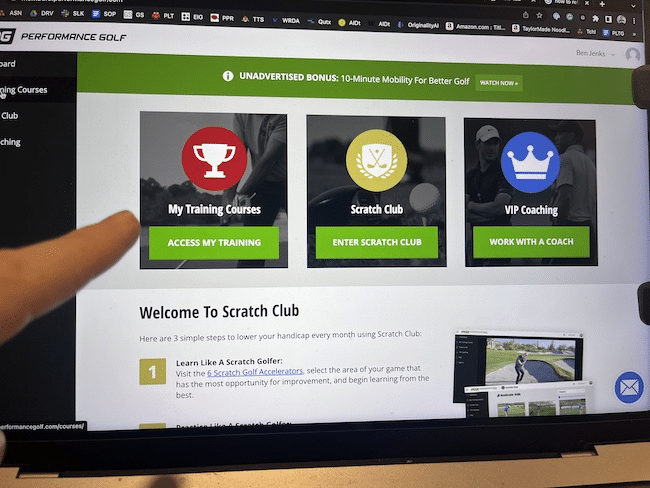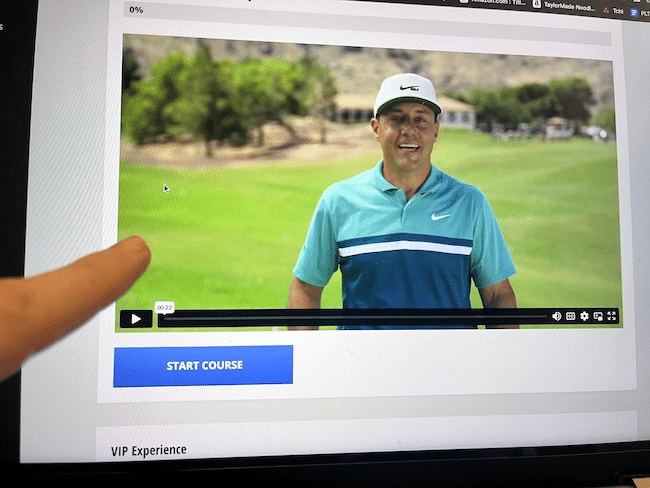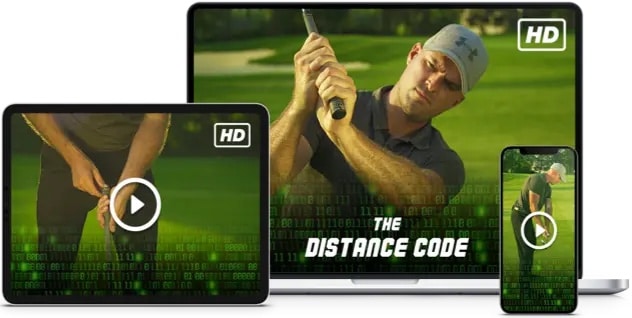The Simple Strike Sequence from Martin Chuck is built to help amateur golfers strike the ball cleaner for consistent launch, distance, and accuracy. In this post, I explain the Simple Strike Sequence, how it works, and how it benefits your golf game.
After reading this review, you will understand how to optimize your ball striking in 10 shots. Plus, I will reveal if it worked for me and whether I feel it is worthwhile for other average golfers struggling with hooks, slices, shanks, duffs, and fat shots.
Here is a rundown of what to expect from our Simple Strike Sequence review:
- Pros and cons of the Simple Strike Sequence
- The Simple Strike Sequence is designed to help you strike the ball cleaner in 10 shots.
- The Simple Strike Sequence video helps you optimize distance
- The Golf Simple Strike Sequence program encourages consistent accuracy
Overview of Martin Chuck’s Simple Strike Sequence Golf Program

Pros
- Promotes cleaner ball striking
- Designed for faster results
- Simple drill
- Built to increase distance
- Encourages straighter shots
- Instant online access
Cons
- I did not appreciate the lengthy marketing video before I understood how it worked.
- It does not work in 10 shots for every golfer.
Rating: 4.35/5
Read More: How To Hit Irons Pure
How Does Simple Strike Sequence Compare To Other Programs?

I feel Martin Chuck has done a brilliant job of simplifying the understanding of swing mechanics in the Simple Strike Sequence. It is easy for high, mid, and low handicappers to grasp and implement. I find other programs, while effective, are complicated for the average golfer, leading to reduced efficiency.
Are You Cursed With A Dreaded Slice? Check Out This 5-Minute Slice Fix
How Does Simple Strike Sequence Work?

The Simple Strike Sequence works through a series of videos, which equip you with the knowledge and tools to consistently execute a clean perfect strikes. Watch the videos, take notes, and implement his instructions on the driving range.
The Simple Strike Sequence training program centers around no-turn and low-point control drills. The no-turn backswing gets your club on the plane at the top and positions you optimally to unload on the downswing for maximum power and control.
Next, the low point control drill teaches you to strike the ball, then the ground to boost your compression. As a result, it helped me maximize ball compression to generate rapid ball speed and controlled spin for a powerful golf shot.
Who Is Simple Strike Sequence For?
The Simple Strike Sequence swing training manual best serves mid and high-handicap amateurs looking to end slices, shanks, hooks, and fluffs. The Simple Strike Sequence promotes solid contact on every strike to produce explosive ball speed and straight flight for optimal distance and precision accuracy.
Simple Strike Sequence: Verdict
My experience with the Simple Strike Sequence program highlights its efficiency in producing cleaner golf shots. I feel its success is mainly due to the simplicity of the explanations, which helps amateurs not overthink the complexities of their swing mechanics.
By focusing on two core areas, I stopped thinking about the nooks and crannies in my swing. Instead, I paid attention to the positioning of my club at the top and bottom of the swing as I went through the 10-shot program.
Overall, I became more cognisant of my arms, wrists, and club position throughout the swing. As the program progressed, I could feel when my club was off plane, and it made it easier to correct the issue before executing the shot.
Read More: Reverse Slice Sequence Explained
Benefits of the Simple Strike Sequence Program

It Simplifies Swing Mechanics
The first advantage of the Simple Strike Sequence tutorial is its simplicity. I found it easier to understand and replicate because I did not need to remember 10 steps. Furthermore, Martin Chuck was not throwing around fancy scientific terms you may hear other coaches fixate on during their lessons.
Instead, Chuck keeps you focused on two core aspects of the swing, namely the top and the bottom. Knowing where my club needed to be at both points was easier to remember than my setup, takeaway, top-of-the-swing position, wrist angles, and rotation through impact.
It Promotes Clean Contact
The sole purpose of the Simple Strike Sequence is to improve your ball striking ability for increased distance and accuracy. Following the 10-shot plan by Chuck teaches you how to guide your clubface to the ball and make clean contact with it.
According to Chuck, it should take only 10 shots to get you striking the ball consistently, but I would allow for more time. However, his methods do work, but fixing poor contact is challenging so some may catch on to the ideas quicker than others.
It Enhances Distance
Clean contact helps you impart maximum velocity onto your golf ball on long shots, leading to a high and powerful launch. Once your ball is airborne, the speed and controlled spin helps it power through the sky and land in the distance, achieving impressive increases of 20-30 yards.
It Improves Accuracy
Besides increasing your yardage from tee to green, clean, consistent ball striking is the key to accurate results. If you strike the ground before your ball, your clubface may pop open when leading into impact, leaving you at risk of slicing your shot.
How To Do The Simple Strike Sequence Golf Technique
1. No-Turn Golf Swing
Step 1 in the 10-shot Simple Strike Sequence plan is the no-turn backswing. I will leave a video for you, but you want to start with addressing the ball and raising your arms straight up. Once your arms are raised, tip the club head backward by 45 degrees.
Without making a turn, you find your arms are out and free from your body, placing you optimally to reach as far from your ball as you can at the top. From the 45-degree angle, rotate your shoulders to coil the club to the top of the backswing point.
As you transition, you should feel the weight of the club resisting the direction your body is traveling. That is golden for shallowing the golf club and creating lag on the downswing, leading to increased power into contact at the perfect strike point.
2. Low Point Control Drill
Although most coaches recommend you hit the ball at the low point of your swing on iron shots, it is not technically correct. This explains that hitting the ball at the low point of your swing is an unlikely endeavor, and golfers who attempt this end up hitting the turf before the ball, leading to a fluffed shot.
In addition, when your clubface hits the grass before the ball, it props your clubface open to the path leading into contact. The outcome is a slice or, at best, a pushed shot, leaving you further right of your target line than intended.
The low point drill teaches you to catch the ball first, then the ground, to ensure your clubface strikes urethan before the grass. Once you consistently hit your ball before the earth, you start to deliver better compression, ball speed, spin, and control.
Ultimately, you will start taking juicy divots ahead of your ball, which professional golfers would appreciate.
Read more: How To Swing A Golf Club
Simple Strike Sequence Golf Practice Routines
1. 5 Shots Practicing No-Turn Golf Swing
I recommend continuously practicing the Simple Strike Sequence program to keep your eye and strike clean. After warming up at the driving range, start your session with 5 shots of the no-turn backswing to focus on getting your club into the optimal position on takeaway and at the top.
At the top of your swing, transition and let the club fall into place as you shallow it on the downswing, delivering increased lag.
2. 5 Shots Working On Low Point Control
Once you are content with your club plane and path, spend the remaining 5 shots on your low point control. Spend the time trying to strike your golf ball first prior to the low point of your swing before taking a chunky divot ahead.
Once you have completed a set of the no-turn and low-point control drills, repeat it if your ball striking is still rusty. Golfers satisfied with their first set can proceed with their intended training regimen for the session.
3. Skill
With your Simple Strike Sequence drills out of the way, it is time to put your training to the test. Chuck suggests that each practice session requires a skills element, a technique element, and a challenge to see growth.
Skills development revolves around enhancing your ability to play different golf shots and getting creative on the range. For example, you practice hitting a draw before switching to a fade. Next, you try to hit high-launching shots and end with low-flying stingers.
Versatility is key for problem-solving on a golf course. You will not hit the fairway and green in regulation every time, and escaping requires creativity.
4. Technique
After you have sharpened your skills, work on your technique. If you are cupping your wrists, leading into impact, and opening your clubface, you try to generate greater flexion. This helps you square the clubface and prompt a straighter launch.
Another example of technical training is working on your no-turn backswing, hand and wrist positioning, knees, hips, torso, and clubhead at the top of the swing.
5. Challenge
The final cog in the Simple Sequence Practice Routine is setting a challenge and achieving the goal. If your iron play is rusty, pick a green on the range and set yourself the goal of hitting 10 balls onto the green before you can call it a day.
Another challenge I often set is to hit 10 draws, fades, stingers, or high shots. I can only turn around and leave once I have conquered my goal.
Simple Strike Sequence Golf Program Results?

I’ve seen the effects of the Simple Strike Sequence program firsthand, and I feel other mid and high-handicappers golfers stand to benefit. My thoughts are corroborated by past users who have found the video training beneficial.
Patrick, a 13 handicapper who had tried all kinds of YouTube tutorial videos, was only more confused and could not find solutions to his erratic striking. However, he mentions that he strikes the clubface consistently since using Martin Chuck’s program.
In addition, Peter, an 18 handicap, reports that he felt it was easy to implement and simpler to replicate on every shot for consistent contact.
Alternative Performance Golf Training Programs
One Shot Slice Fix
Hank Haney’s One Shot Fix offers a straightforward, focused approach to tackling one of golf’s most common problems: the dreaded slice. Built around the mechanics of wrist action during your downswing, the program aims to correct your clubface angle, helping you achieve a more targeted and controlled ball flight.
The positives include its simplicity, offering immediate improvements for some golfers, and a comprehensive look at grip, body alignment, swing path, and even equipment. The one notable downside is the program’s “one-shot fix” claim, which might be a bit ambitious for some golfers. While it’s not a universal cure-all, Haney’s method provides valuable insights and techniques for those looking to quickly address their slice issues.
Get More Distance
Short Game Secrets
FAQ
Who Can Benefit From The Program?
Beginners and mid-handicappers can benefit from the Simple Strike Sequence program because it is easy to understand and delivers quick results.
How Long Does It Take To See Results With The Simple Strike Sequence Golf Program?
Martin Chuck designed the Simple Strike Sequence to see results in 10 shots. After following his instructions, you should deliver a better percentage of clean strikes than in your past rounds.
Is The Simple Strike Sequence Golf Program Program Suitable For Beginners?
Yes, the Simple Strike Sequence Golf Program is suitable for beginners because it is easy to understand, affordable, and effective.
How Much Does The Simple Strike Sequence Program Cost?
The Simple Strike Sequence Program video costs $47. It includes added extras like the Simple Strike Driver Series and the Confidential Guide to Ball Striking.
What Is Included In The Simple Strike Sequence Program?
The Simple Strike Sequence Program includes a video tutorial to help you strike the ball cleanly in 10 shots. In addition, you receive access to the Simple Strike Driver Series, Confidential Guide to Ball Striking, Simple Strike Training Academy Live Streams, and an In-Person Tour Striker Experience.
Conclusion
My Simple Strike Sequence review reveals that Martin Chuck has developed an effective, easy-to-understand course for all golfers to strike the ball cleanly. However, I feel it offers the most value to mid and high-handicap golfers who are desperate to consistently get the ball airborne and generate increased yardage off the tee.
It is impressive to see that the no-turn golf swing and low point control drill can positively impact your ball striking consistency. If you are tired of the embarrassment that comes from tooth, chunk, shank, hook, or slicing your shots or drives, think about giving the Simple Strike Sequence a go.
Matt has played golf since he was 4 years old and has written over 150 articles at GolfSpan since 2021. Matt specializes in product reviews using his postgraduate degree in Sports Marketing from Johan Cruyff Institute. Matt has a handicap index of 10.8 and currently plays weekly at Pilar Golf Course near his home in Buenos Aires, Argentina. He also loves his Callaway Odyssey Exo Rossie putter and likes a pepper steak pie with curry gravy at the turn. You can connect with him on LinkedIn.










